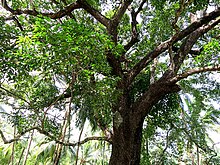This article needs additional citations for verification. (October 2019) |
Mimusops elengi is a medium-sized evergreen tree found in tropical forests in South Asia, Southeast Asia and northern Australia. English common names include Spanish cherry,[2] medlar,[2] and bullet wood.[3] Its timber is valuable, the fruit is edible, and it is used in traditional medicine. As the trees give thick shade and flowers emit fragrance, it is a prized collection of gardens.[4] It is used as an ornamental tree in many places. The flowers may also be used in natural perfume.
| Mimusops elengi | |
|---|---|

| |
| Scientific classification | |
| Kingdom: | Plantae |
| Clade: | Tracheophytes |
| Clade: | Angiosperms |
| Clade: | Eudicots |
| Clade: | Asterids |
| Order: | Ericales |
| Family: | Sapotaceae |
| Genus: | Mimusops |
| Species: | M. elengi
|
| Binomial name | |
| Mimusops elengi | |

Its flower is the provincial flower of Yala Province, Thailand, as well as the city flower of Ampang Jaya, Selangor, Malaysia.[5][6]
Tree description
editBullet wood is an evergreen tree reaching a height of about 16 m (52 ft). It flowers in April, and fruiting occurs between June and October. The leaves are glossy, dark green, oval-shaped, 5–14 cm (2.0–5.5 in) long, and 2.5–6 cm (0.98–2.36 in) wide. The flowers are cream, hairy, and scented. The fruits are fleshy, range in color between yellow and brown, and contain a large brown seed. The pulp has a yellow color and it is edible. The bark of the tree is thick and appears dark brownish black or grayish black in colour, with striations and a few cracks on the surface. The tree may reach up to a height of 9–18 m (30–59 ft) with about 1 m (3 ft 3 in) in circumference.
The seeds are just like the seeds of custard apple. About 1 to 1.5 cm in length and have a brownish black hard coat. They are quite easy to germinate. The process of soaking is helpful in speeding up the germination process. The trees like full sun. They grow with a moderate pace.
Distribution
editThe plant is native to South and Southeast Asia, particularly the coastal areas of the Indian subcontinent, Vietnam and Myanmar, as well as Northern Australia.[7] It was introduced in China in the 20th century, and is now cultivated in its south, as well as in Taiwan.[8]
Other uses
edit- The flowers are sun dried and used to make floral infusions and as an addition to green tea in Thailand.
- The edible fruit is softly hairy becoming smooth, ovoid, bright red-orange when ripe.
- The wood is a luxurious wood that is extremely hard, strong and tough, and rich deep red in color. The heartwood is sharply defined from the sapwood. It works easily and takes a beautiful polish. Density is 1008 kg per cubic meter.
References
edit- ^ Barstow, M. (2019). "Mimusops elengi". IUCN Red List of Threatened Species. 2019: e.T61964765A61964768. doi:10.2305/IUCN.UK.2019-1.RLTS.T61964765A61964768.en. Retrieved 19 November 2021.
- ^ a b Bailey, L.H.; Bailey, E.Z.; the staff of the Liberty Hyde Bailey Hortorium. 1976. Hortus third: A concise dictionary of plants cultivated in the United States and Canada. Macmillan, New York.
- ^ "Mimusops elengi". Biodiversity It is known as bakul in India. Retrieved 14 October 2013.
- ^ "Maulsari". flowersofindia.com. Retrieved 14 October 2013.
- ^ "ประวัติ จังหวัด ยะลา-Yala Province". Archived from the original on 2013-11-09. Retrieved 2013-03-25.
- ^ "BUNGA RASMI MPAJ". Portal Rasmi MAJLIS PERBANDARAN AMPANG JAYA. 12 August 2015. Retrieved 15 November 2019.
- ^ "Mimusops elengi L. | Plants of the World Online | Kew Science". Plants of the World Online. Retrieved 2022-02-07.
- ^ 中国热带主要外来树种. ISBN 9787541654701.
Further reading
edit- Brock, J., Top End Native Plants, 1988. ISBN 0-7316-0859-3
